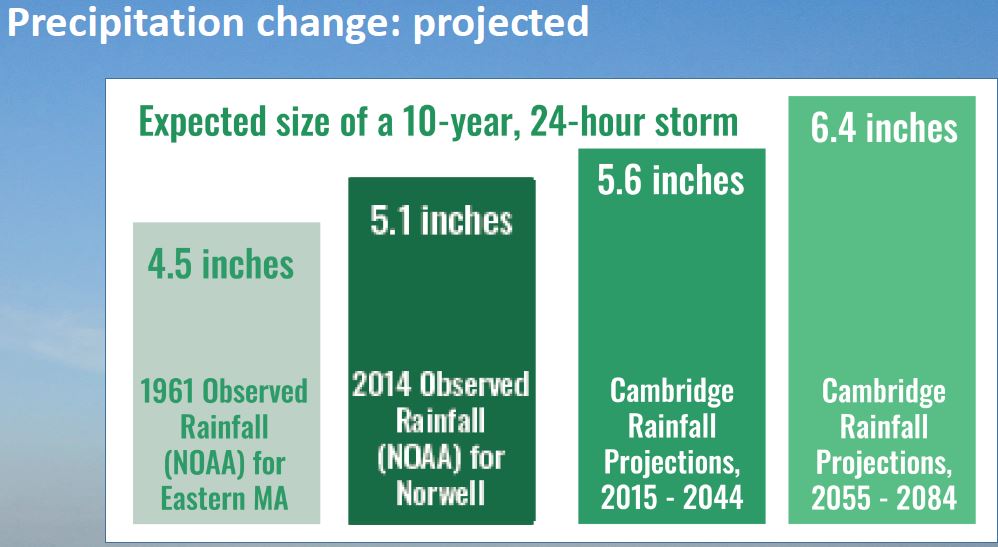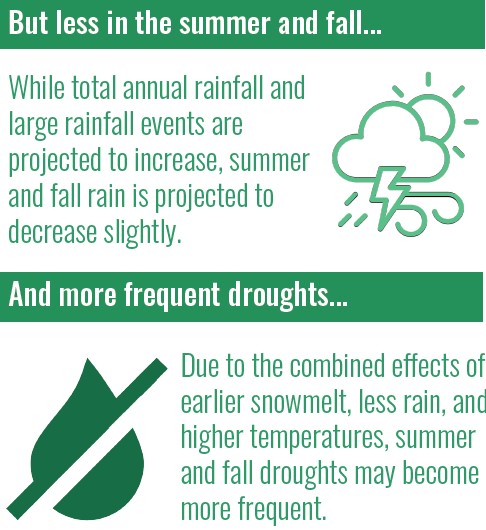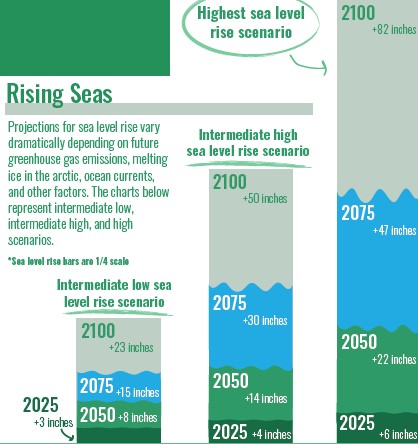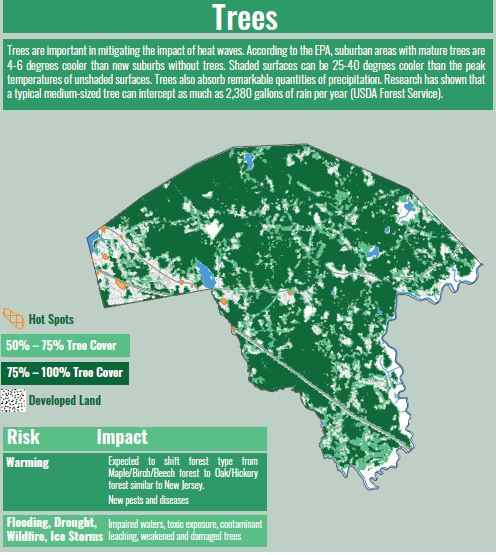“It is not the strongest of the species that survives, but rather, that which is most adaptable to change.” ~ Charles Darwin
 Floods, water quality, forest fires, droughts, extreme heat… these are just some of the natural disasters that are becoming more frequent, more dangerous and more costly as the climate changes.
Floods, water quality, forest fires, droughts, extreme heat… these are just some of the natural disasters that are becoming more frequent, more dangerous and more costly as the climate changes.
The climate may be changing, but our infrastructure including buildings, drainage systems, roads and bridges, wastewater and water systems were all built for a climate that was static and in the past. For example, our drainage systems were built on observed rainfall amounts from 1961 and are already undersized by 13% compared to the rainfall we are observing today. That trend will continue to worsen as storms increase in intensity.
 On the flip side of the water coin, while total annual rainfall and large rainfall events are projected to increase, summer and fall rain is expected to decrease. Thus more frequent droughts are anticipated to occur in the summer and fall due to the combined effects of earlier snowmelt, less rain and higher temperatures. Most water supplies on the South Shore are already at their limits and many already cause significant ecological damage to our surface waters through overuse. More droughts will exacerbate these conditions.
On the flip side of the water coin, while total annual rainfall and large rainfall events are projected to increase, summer and fall rain is expected to decrease. Thus more frequent droughts are anticipated to occur in the summer and fall due to the combined effects of earlier snowmelt, less rain and higher temperatures. Most water supplies on the South Shore are already at their limits and many already cause significant ecological damage to our surface waters through overuse. More droughts will exacerbate these conditions.
 Rising seas are also anticipated as the oceans expand and glaciers melt. Sea levels are expected to increase from 8 to 22 inches by 2050 depending on how much carbon emissions are curbed. Our coastal communities are already contending with the 11 inches in sea level rise observed between 1921 and 2018 at the Boston tide gauge.
Rising seas are also anticipated as the oceans expand and glaciers melt. Sea levels are expected to increase from 8 to 22 inches by 2050 depending on how much carbon emissions are curbed. Our coastal communities are already contending with the 11 inches in sea level rise observed between 1921 and 2018 at the Boston tide gauge.
These issues pose unprecedented challenges to communities in Massachusetts, however, the state has a program to help your town adapt and it incentivizes communities to build with nature in mind. In 2017 the state launched its Municipal Vulnerability Preparedness Program (MVP) and many communities on the South Shore including Hull, Weymouth, Hingham, Scituate, Duxbury, Marshfield, and Norwell to name a few, are in different stages of the program.
The first stage requires the town to become certified by identifying and prioritizing actions needed to make their town more resilient to climate change impacts. The process involves getting a cross section of people together from first responders, public works, local businesses and organizations like watershed associations. This group helps to identify the town’s strengths and weaknesses regarding both natural and manmade assets in the town that are vulnerable to climate change. It also identifies local populations that might be at risk or vulnerable.
 The NSRWA has participated in the MVP planning process for most of the communities on the South Shore, to bring our own local knowledge and expertise on water issues facing our region and ensure that protecting our water for nature and people is at the forefront. These plans are important because they will drive what projects the towns can request support for from a grant program that has, in the last two years, provided over $15 million in funding for on the ground climate resiliency projects.
The NSRWA has participated in the MVP planning process for most of the communities on the South Shore, to bring our own local knowledge and expertise on water issues facing our region and ensure that protecting our water for nature and people is at the forefront. These plans are important because they will drive what projects the towns can request support for from a grant program that has, in the last two years, provided over $15 million in funding for on the ground climate resiliency projects.
For example, the NSRWA recently partnered on a request for funding for raising the reservoir in the town of Scituate that will make their town more resilient to drought and restore access for river herring and other vulnerable and protected species. Last week we participated in Norwell’s MVP planning workshop and it was, as most of these have been, an eye opener! Just getting all of the different people in the same room is a minor miracle, never mind having them for a full day. The local knowledge, challenges, ideas, and true caring for the community that came from this diverse group was really inspiring. The graphics in this article are a sample of the posters that were provided for the group to use as they determined the town’s strengths and weaknesses and identified actions that can build a more climate resilient Norwell. For example, trees were identified as a strength and a weakness in Norwell – a strength because they offer shading and allow for water to infiltrate into the ground rather than runoff like pavement, but climate change is weakening them through disease, heat and drought stress, and storm damage.
Norwell, like most of the South Shore, is also undergoing a seismic demographic shift toward older adults. By 2030, over 25% of Norwell’s population will be 65+ and many will live alone. These older populations living on a fixed income may be more vulnerable to a changing climate and need to be considered when thinking about how we are going to adapt.
Adapting to Nature
Instead of trying to work against nature we are working for ways to help our communities to work with nature to adapt to climate change. Nature based projects or green infrastructure solutions seek to mimic natural systems and include projects such as building rain gardens that allow rain to infiltrate into the ground to recharge our drinking water, reduce flooding and keep our water clean or dam removal that will provide flood plain storage and improve fish habitat. The MVP program is still in its infancy, but we look forward to developing more nature based projects that will help our communities to adapt to climate change.
Graphics courtesy of Metropolitan Area Planning Council (MAPC).
